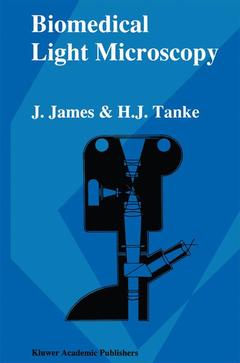Description
Biomedical Light Microscopy, Softcover reprint of the original 1st ed. 1991
Authors: James J., Tanke H.J
Language: English
Publication date: 10-2012
192 p. · 15.5x23.5 cm · Paperback
192 p. · 15.5x23.5 cm · Paperback
Description
/li>Contents
/li>
New interest in light microscopy of the last few years has not been backed up by adequate general literature. This book intends to fill the gap between specialized texts on detailed topics and general introductory booklets, mostly dealing with the use of the conventional light microscope only. In this short textbook both new developments in microscopy and basic facts of image formation will be treated, including often neglected topics such as axial resolving power, lens construction, photomicrography and correct use of phase-en interference contrast systems. Theoretical background will be dealt with as far as necessary for a well-considered application of these techniques enabling a deliberate choice for the approach of a certain problem. Over 150 illustrations (photomicrographs and diagrams) complete the information on microscopy of the nineties in the biomedical field, intended for scientists, doctors, technicians and research students. Many drawings have been contributed by the illustrator R. Kreuger; the photographic work has been executed by J. Peeterse. Secretarial assistance in preparing the manuscript was given by Ms T. M. S. Pierik. Dr M. J. Pearson has corrected the English of the final text.
1. Light microscopy as an optical system, the stand and its parts.- 1.1 Basic theory.- 1.2 The objective as an optical tool; resolving power.- 1.3 Eyepieces.- 1.4 Objective and eyepiece as an integrated system.- Recommended further reading.- 2. The light microscope as a tool for observation and measurement: illumination and image formation.- 2.1 Modulation of the illuminating light by the object.- 2.2 The stand and its parts.- 2.3 Illumination and image formation.- Recommended further reading.- 3. Fluorescence microscopy.- 3.1 Theoretical background.- 3.2 The fluorescence microscope.- Recommended further reading.- 4. Special optical techniques of image formation.- 4.1 Phase-contrast microscopy.- 4.2 Interferometry and interference contrast.- 4.3 Modulation-contrast microscopy.- 4.4 Polarization microscopy.- 4.5 Reflection microscopy and reflection-contrast microscopy.- 4.6 Acoustic microscopy.- 4.7 Superresolution: modern developments.- Recommended further reading.- 5. Reproduction of microscopic images, microphotography.- 5.1 Drawing and drawing apparatuses.- 5.2 Microprojection.- 5.3 Television microscopy.- 5.4 Photomicrography.- Recommended further reading.- 6. Quantitative analysis of microscopic images.- 6.1 Introduction.- 6.2 Morphometric techniques.- 6.3 Counting methods.- 6.4 Absorption and fluorescence measurement of cells.- 6.5 Absorption cytophotometry (cytophotometry or microphotometry).- 6.6 Fluorescence cytophotometry (cytofluorometry, microfluorometry).- 6.7 Flow cytometry.- 6.8 Microspectrophotometry.- Recommended further reading.- 7. Automation: image analysis and pattern recognition.- 7.1 General introduction.- 7.2 Scanning of microscopic objects: special cameras.- 7.3 The digitized image.- 7.4 Image analysis.- 7.5 Pattern recognition.- Recommended further reading.- 8. Appendix: technical aspects of the microscopical observation in practice.- 8.1 Introduction.- 8.2 Setting up a microscope for Köhler illumination.- 8.3 Again: the object.- 8.4 On the way through the object.- 8.5 Maintenance and minor technical problems.- 8.6 Frequently occurring minor defects.- Recommended further reading.- Index of subjects.
© 2024 LAVOISIER S.A.S.



